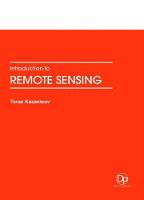


|
|
|
books
| book details |
Introduction to Remote Sensing
Edited by Taras Kazantsev

|
This book is currently unavailable. Enquire to check if we can source a used copy
|
| book description |
Remote sensing is the art and science of recording, measuring, and analyzing information about a phenomenon from a distance. Humans with the aid of their eyes, noses, and ears are constantly seeing, smelling, and hearing things from a distance as they move through an environment. Thus, humans are naturally designed to be remote sensors. In order to study large areas of the Earth’s surface geographers use devices known as remote sensors. These sensors are mounted on platforms such as helicopters, planes, and satellites that make it possible for the sensors to observe the Earth from above. Aircraft and satellites are the common platforms for remote sensing of the earth and its natural resources. Aerial photography in the visible portion of the electromagnetic wavelength was the original form of remote sensing but technological developments has enabled the acquisition of information at other wavelengths including near infrared, thermal infrared and microwave. Collection of information over a large numbers of wavelength bands is referred to as multispectral or hyper-spectral data. The development and deployment of manned and unmanned satellites has enhanced the collection of remotely sensed data and offers an inexpensive way to obtain information over large areas. The capacity of remote sensing to identify and monitor land surfaces and environmental conditions has expanded greatly over the last few years and remotely sensed data will be an essential tool in natural resource management. The era of satellite remote sensing was open in the 1960s when cameras and electronic sensors were mounted on spacecraft. Nowadays there is a big assortment of satellite systems actively recording information about the Earth. A wide variety of imagery is available from satellites. Both active and passive sensors, operating from the microwave to the ultraviolet regions of the electromagnetic spectrum collect a large amount of information about the earth’s surface every day. Each of the systems vary in terms of their spatial, spectral, radiometic and temporal resolution. Remote sensing makes use of visible, near infrared and short-wave infrared sensors to form images of the earth’s surface by detecting the solar radiation reflected from targets on the ground. Different materials reflect and absorb differently at different wavelengths. Thus, the targets can be differentiated by their spectral reflectance signatures in the remotely sensed images. Remote sensing imagery has many applications in cartography, land use and cover, agriculture, soils mapping, forestry, city planning, grassland management, archaeology, military observations, meteorology, and geomorphology, among other uses. In order to use such imagery, one must have considerable knowledge about the Earth’s surface and a strong background in remote sensing data acquisition and analysis techniques. Since the Earth’s surface consists of a mosaic of environmental conditions, geographers through their unique training in both the sciences and social sciences are well qualified to undertake various remote sensing applications.
| product details |
Normally shipped |
Publisher | Delve Publishing
Published date | 30 Nov 2016
Language |
Format | Hardback
Pages | 270
Dimensions | 229 x 152 x 0mm (L x W x H)
Weight | 0g
ISBN | 978-1-6809-5668-9
Readership Age |
BISAC | science / earth sciences / geography
| other options |
|
|
|
To view the items in your trolley please sign in.
| sign in |
|
|
|
| specials |
|
Look around you is anything real or normal any more? News, images and videos created by AI are everywhere.
|
|
This first comprehensive biography of Cecil Rhodes in a generation illuminates Rhodes’s vision for the expansion of imperialism in southern Africa, connecting politics and industry to internal development, and examines how this fueled a lasting, white-dominated colonial society.
|
|
|
|
|